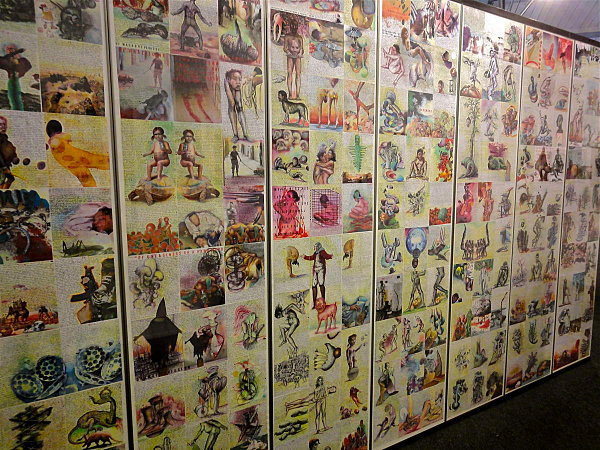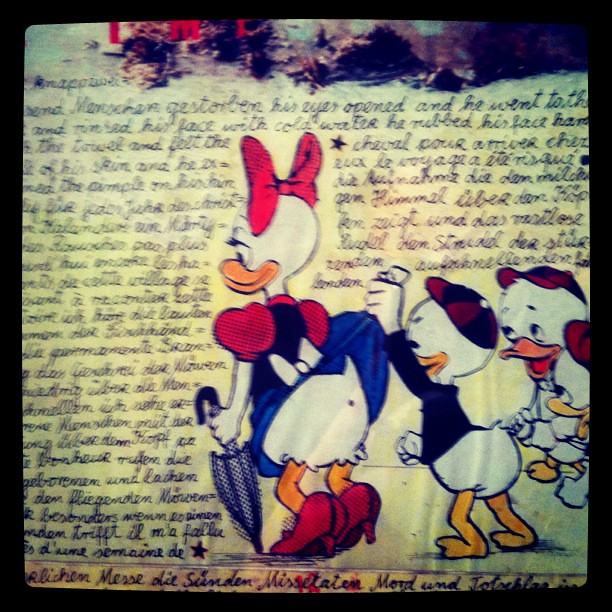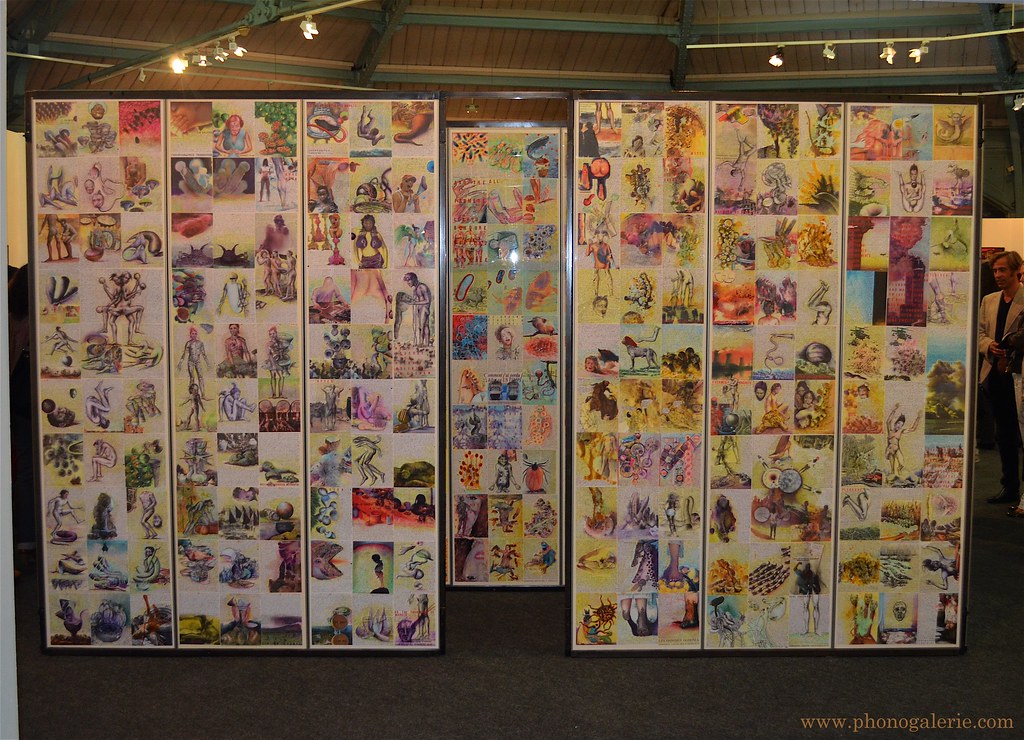
Tekstualno-kolažni dnevnici. Prijepis unutrašnjeg sadržaja informacijske bombe. Manijakalni, srednjovjekovni obračun sa svijetom.
www.horsthaack.com/










































































































































Terrestrial Terroaring: A Dialogue with Horst Haack
In the glossy &colorful March/April 2011 issue of Art Actuel, there is much for the eye to feast upon. However, amidst the retinal smorgasbord & “innovative” brouhaha, there are four full page spreads, featuring 22×17 cm. square upon 22×17 cm. square of human bodies morphing full-on mutant against a dense multilingual curtain of text.
The vying violence lances at you amidst a fragmented landscrape of phrases detritused from English, German & French as bio-illogical forms are freeze-framed into an eternal scream, as if the Emergency Broadcasting System screep blossomed into cyclone-clots of color.
These panels are the latest additions to Chronographie Terrestre (Work in Progress), the 30-year long opus of German artist Horst Haack. Diminutively dubbed a “visual diary,” Haack counters our GO! GO! GO! capitilesst attention spans & carefully & obsessively chronicles how we’re collectively swallowed by the avalanching discourse that surrounds us.
What’s striking about Haack’s work is the infinite variation that he finds in repetition: while each 22 X 17 cm. frame in Chronographie (& oftentimes his other works) has the same basic layout, the images always present a new angle upon the work’s larger themes.
A witty and sometimes whimsical commentator, Haack generously agreed to an email exchange. (For more pictures and information on Haack, visit his website: http://www.horsthaack.com/index.html)

Jared: Your art makes extensive use of written texts from multiple languages. For me, your use of these texts seems to have two thrusts: 1.) they are words to be read and 2.) material objects to be manipulated. How do you see the written word operating in your art? What do you see as the relationship between word and image here?
Horst: Yes the words/phrases, text-collages in my art are meant to be read. They function in a field, where colors, forms and images stimulate the text. They paint and tint the meanings/semantics and vice versa. Or boy meets girl, word and image alternate and produce another third body of meaning.
Jared: I’m interested in this 3rd body of meaning! Do you see this body of meaning as another form of visual communication or does it use the combination of word/image to create meanings beyond the visual realm? In other words, does the juxtaposition of images and words produce meanings that are not physically present within the work?
Horst: Think of a photograph showing a beautiful boy or girl. Now you have written information with it: “this person has tested HIV positive today.” Same picture but the legend: “this youth jumped off the bridge into the river without knowing how to swim and saved a child from drowning.” Would you not experience with the same picture two different “3rd bodies of meaning”? Now imagine the same two legends with the photograph of a dog.
Jared: Cool scenarios to illustrate your point! Now that we’ve discussed the word/image relationship, I was wondering if we could talk about each of them separately. Let’s start with the images. Whether it’s Chronographie Terrestre, your other installations, or your books, you produce these remarkable representations of the human body undergoing often violent transformations. What attracts to you to creating this kind of imagery?
Horst: In the old days, people used to go, on market days, to see the side show. They paid and looked at unbelievable things, like a woman with three legs or a calf with two heads. People love to experience the unusual; they still do nowadays in film and TV. Still, the artist wants to tell/draw what he feels, what he saw. He does not want to tell, that he saw nothing/felt nothing or very little. I do not see that I am exaggerating. What I do seems natural to me. I cannot see that I am overstating. I am probably born with this twisted view.
Jared: You’ve visually collaborated with a wide range of written texts: T.S. Eliot’s “The Waste-Land,” The Revelation of Saint John, a letter from Ulrike Meinhof, etc. What kinds of texts do you find particularly useful for your artwork?
Horst: The wide range of authors you talk about is rather narrow, four or five authors. Most of my books show my own texts. The Revelation is probably the most moving and mighty and original text-collage ever mounted. Beside this fact is The Revelation to me a very personal affair, an intimate affair with Albrecht Dürer. Exactly 5oo years after A.D. I simply tried to top his version. I chose Eliot because “The Waste-Land: is stuffed with powerful illuminated metaphors, also a collage. Eliot has to my knowledge never been done. When I read the Ulrike Meinhof letter first, it gave me the creeps, goose pimples… an account on her own “white torture”. I had to get up, walk around while reading it. I decided to make the words visible. I am sure it is a German affair. And still like so many I am against torture.
Jared: Your last response opened up another avenue of interest: How much of your text-collages comes from other sources and how much is your own writing (from journals or what not)? Why is collage such a useful tool for your art? Is it meant to give your work more of a political edge by rooting it in society’s crazy intersection of voices and discourses?
Horst: Our thinking, awareness, our desires and souvenirs are collage. Our life is collage, our dreams. Isn’t it? Sources: about a third is written in German ( my journal, notes) also the meandering passages, the linguistic links to French and English (news, headlines, reports from nature, politics and arts, sports, curiosities, etc.) are given in German. I want my art to be rooted in the present.
Jared: What comes first in your work, the images or the texts? Or is it different with each work? Also, your imagery focuses extensively on biological life-forms and even at their most abstract, your pictures have a recognizably cellular quality. Is there a political/ecological advocacy in such a focus, an attempt to capture how the present day is affecting/transforming organic life?
Horst: In my Chronographie every sheet of every panel begins with the image. The text follows. No, there is no ecological quest. I am hardly aware of what you call “biological life-forms”. Even blindfolded (and I have tried) my drawings and scribblings turn into cellular structures. It’s like leaving your fingerprints while playing chess or piano without gloves.
Jared: Your work seems to be primarily displayed in galleries/museums, but you experiment in media associated with mass-distribution such as books. Have you thought of publishing your art in book form rather than displaying it in the gallery setting?Chronographie Terrestre would also seem to operate quite nicely as a book or an interactive digital archive. What do you feel the relationship between art and the emerging digital technologies should be?
Horst: Tapestry, mosaic, fresco, vase-painting, only to name a few, have already vanished. As serious art forms they don’t exist anymore. Lithography, etching, woodcut have become rare techniques. Painting, photography will probably follow. I am not familiar with digital art. I have done for some years lecture-performances with my panels via a video camera. I stopped that after having seen a film of one of the sessions. Not good enough, to my taste. Anyway, most video art I have seen looked like dilettante film to me. I am probably too old for these techniques.
Jared: Since I’ve been asking question primarily about your methods, I was thinking that maybe we could change gears & talk about your views on art overall. What do you see as art’s primary goal? Or does it (should it) even have one?
Horst: No Jared, I cannot tell what art is about. You are almost asking for the meaning of life. We don’t know it. Some need art to alter their existence, some need art to decorate their walls, others try to make money. There is no answer to what art is, to my knowledge. Nobody knows what art is, some will tell you what art is not. But that of course seems much easier. I think we should come back to simpler questions.
Jared: You seem to be a very international artist. Where do you find the best reception for your work?
Horst: My work has been shown in different countries, but that does not make me an international artist. Reception I have known little. Naturally, countries in which the languages English, French and German are spoken or understood are an advantage for the reception. Holland, Belgium, Switzerland and so forth. Small countries like Luxemburg are very good at languages and art friends there will probably have an easy access to my world.
Jared: How has your artwork changed over the years and what has prompted those changes?
Horst: One day when I had finished installing the cabinet/ cage consisting of 76 panels, I said to the friend who had helped me, “Amazing, how the images, how the whole work has changed through the years.” He looked at it. “Yes ,” he said, “naturally, it is because you’ve stayed the same.” He was right. The world had changed. It does so every day, every hour.
Jared: Despite the changes in your art, you consistently use very lush, violent, and brilliant colors. What kinds of colors do you find the most productive? What do you think color adds to an artwork?
Horst: Take a vermillion red, paint some cherries and you may get haiku. Take ink blue, do the cherries and you get none. That is what color adds. On one hand, you have color without form, on the other form without color. Both together will increase /heighten /enhance each other considerably. I don’t like colors that remind me of vomitus.
Jared: Do you seek to elicit certain kinds of responses from viewers of your art? Or do you do prefer to leave the interpretation open to them?
Horst: No. I don’t have anything to teach. I hope my images are precise and attracting enough to raise the right questions. It’s up to the viewer to find the right answers.
Jared: So then do your artworks try to start a dialogue with their viewers? During your exhibitions, have you gotten a chance to observe viewers’ reactions to those artworks? If so, what kinds of responses were generated? One question that has been in my mind for a while is how both writers & visual artists can still engage audiences in a contemporary culture bombarded with texts & images. How does one stop their work from being passively absorbed as part of the information-flooded landscape?
Horst: You are right: our presence is bombarded with information like never before, with images and words. Nobody can assure that an artwork containing these elements will not be consumed as a poster or an advertising. How does an active onlooker behave? I have no idea. Most the time, visitors to my exhibitions complain about the complicated interaction between image and word. Children and youth have no problem with diving into the wall of panels and discover. Having grown up with comics instead with Proust or Twain, young art-lovers have much less difficulties. A possible dialogue with the audience would be that I ask the questions and the viewer tries the answer.
Jared: How was the response to this most recent show?
Horst: It is complicated. If an artist asks you what you think of his work, he secretly or openly wants to be praised. And of course, he wants you to say the truth. So I never ask.
Jared: What has attracted you to creating long-term projects like Chronographie Terrestre? Do such projects allow you to address topics or attempt experiments in a way that one-shot projects cannot? What’s keeps you motivated to adding to such projects?
Horst: I have artist friends whose studio, livingroom, bedroom, cave and garage are filled up with paintings that nobody wants. When I came to live in Paris in 1979, nobody wanted my stuff and I decided to shrink. Since I was poor, I choose a small format and poor materials, any piece of paper with the size 22×17 cm. It still is the same. 3o pieces made one month to begin with. As I said, nobody wanted what I was doing, so I was free to do anything of real concern without any consideration. The motivation was and probably still is to witness, to give testimony, to express: Horst has lived.

Nema komentara:
Objavi komentar